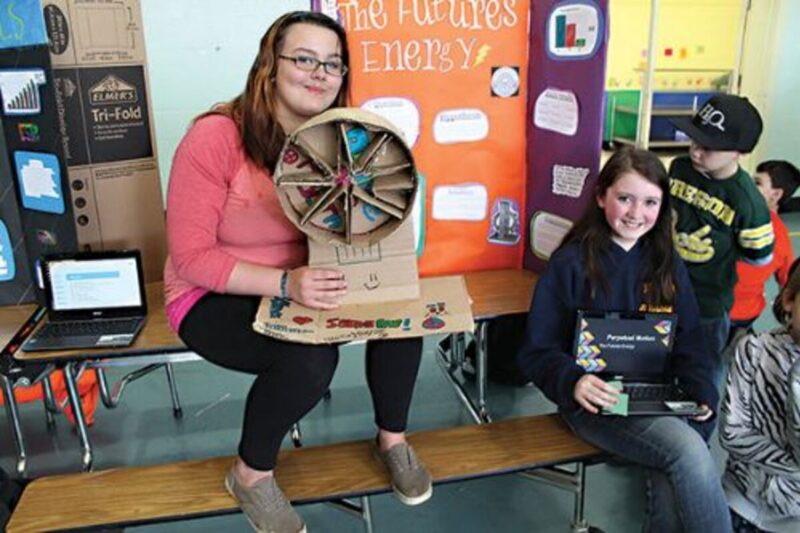Sean C. Morgan
If you wear Air Jordans, commercials hint, you will jump higher than wearing other brands. If you use a Chromebook, you’ll be able to explain it.
Holley sixth-grader Kobe Pepple had the usual poster board with photos and notes during the school’s science fair Thursday, but he also had a new Acer Chromebook sitting in front of a posterboard background.
Tabbing through a presentation he’d prepared on the Chromebook, he explained that, based on testing against a yard stick, Jordans and Under Armour are the best gear for jumping, followed in order by Nike Flights, Romeos, Vans and Etnies.
Kobe said having the Chromebook laptop made a difference in his presentation.
“I like it,” he said. “It helps a lot. It’s easier than typing.”
“It’s easier to set up (than the poster board),” added sixth grader Jake Evans.
“A lot of times, people see this and they didn’t want to read all this,” said teacher Kyle Moeller, referring to the students’ posterboard displays and notes. “This (the Chromebook presentation) is the boiled-down version. It’s been great. The things it allows us to do is amazing.”
It’s allowing students to do things right at their desks that they couldn’t do before, Moeller said. They can use them for research and work together using Google Drive, a cloud service, to prepare presentations.
The Holley Parent Teacher Club purchased 40 of the Chromebooks at about $250 each, about a month ago, said Michelle Keene, media specialist, with another seven provided to staff members.
Chromebooks are small simple laptops using the Google Chrome operating system, based on the Linux operating system. Users interact primarily with the Google Chrome browser, with other apps available from Google’s store. They boot in seconds, far faster than starting a laptop with an Apple or a Windows operating system. Users store data in the cloud with Google Drive or on flash drives.
Sweet Home Junior High School Site Council members are applying for grants to build mobile Chromebook labs too, said Principal Colleen Henry. The school has a mobile lab filled with IBM Thinkpads, Windows-based machines, it purchased six years ago.
The fifth- and sixth-grade classes at Holley trade a cart of 30 of the Chromebooks back and forth on a weekly basis, Moeller said, and the PTC is working on filling a second cart next year. That would allow the classes to have a Chromebook in every student’s hands all the time.
“They’ve helped us with our typing,” said sixth-grader Madison Williams. “We don’t have to go to our computer lab every single day.”
The computers provide a versatile classroom tool that is easier to maintain because it has no superfluous software. Battery life is six hours, and logging in takes 10 seconds.
They’re also light, weighing in at 6 pounds, with an 11-inch screen, Henry said.
Teachers can use it to communicate helpful information to students, she said. Teachers can easily give students a scoring guide for their assignments in a paperless digital environment. They’re comfortable with it, and Google provides numerous apps that can be helpful to teachers. Plus, students can access their work remotely, from any computer with Internet access, including home.
“The Chromebook is kind of one of those emerging technologies,” she said. “Part of preparing kids for the future is making sure they have the skills future employers, future society requires.” The state requires they learn the technology, “netiquette” and Internet safety. This helps them do that, she said.
Holley fifth-grade teacher Brett Bowers said his students have been using them to research their science projects, keyboarding practice and running math programs, mostly at ixl.com. With Google Drive access and accounts for every student, they’re able to work on spreadsheets, word processors and presentations.
It’s giving “one-on-one access child to computer for the whole, entire day,” Bowers said. “Not to sound cliché,” he added, but it opens a whole new array of things he can do in his classroom. When classrooms have two or three computers, and students must wait to get access when they need to use computers.
Keene said teachers can access the students’ work any time and they can see who has contributed how much to group projects, and she can make sure every Chromebook has that apps the students need.
“I can go out and purchase apps, and it will go out to each one,” she said.
Right now, the mobile Chromebook labs don’t do everything.
“We’ll still do testing, and probably the younger kids will still work in the lab,” Keene said. State testing opportunities may be available later.





